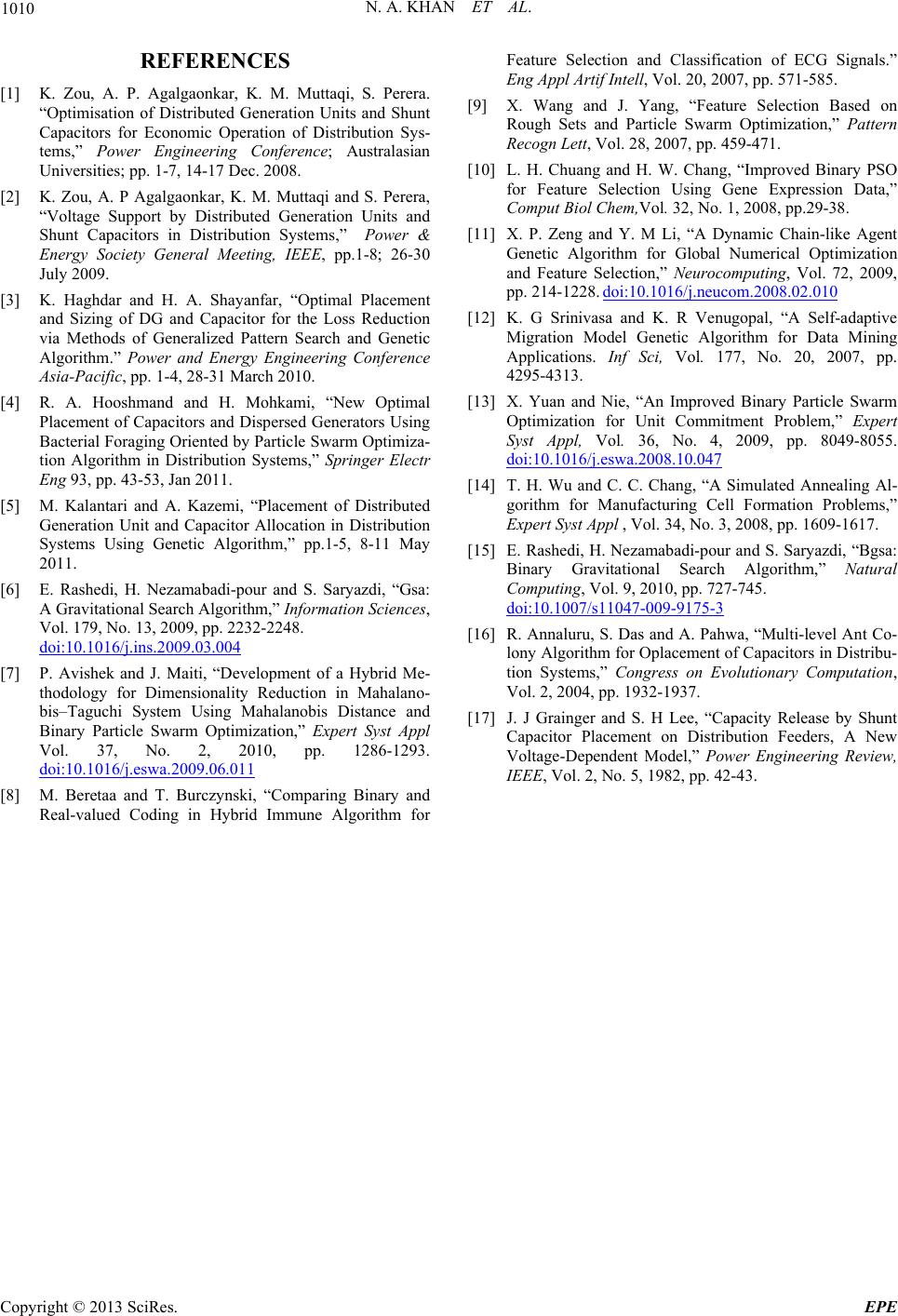
N. A. KHAN ET AL.
Copyright © 2013 SciRes. EPE
1010
REFERENCES
[1] K. Zou, A. P. Agalgaonkar, K. M. Muttaqi, S. Perera.
“Optimisation of Distributed Generation Units and Shunt
Capacitors for Economic Operation of Distribution Sys-
tems,” Power Engineering Conference; Australasian
Universities; pp. 1-7, 14-17 Dec. 2008.
[2] K. Zou, A. P Agalgaonkar, K. M. Muttaqi and S. Perera,
“Voltage Support by Distributed Generation Units and
Shunt Capacitors in Distribution Systems,” Power &
Energy Society General Meeting, IEEE, pp.1-8; 26-30
July 2009.
[3] K. Haghdar and H. A. Shayanfar, “Optimal Placement
and Sizing of DG and Capacitor for the Loss Reduction
via Methods of Generalized Pattern Search and Genetic
Algorithm.” Power and Energy Engineering Conference
Asia-Pacific, pp. 1-4, 28-31 March 2010.
[4] R. A. Hooshmand and H. Mohkami, “New Optimal
Placement of Capacitors and Dispersed Generators Using
Bacterial Foraging Oriented by Particle Swarm Optimiza-
tion Algorithm in Distribution Systems,” Springer Electr
Eng 93, pp. 43-53, Jan 2011.
[5] M. Kalantari and A. Kazemi, “Placement of Distributed
Generation Unit and Capacitor Allocation in Distribution
Systems Using Genetic Algorithm,” pp.1-5, 8-11 May
2011.
[6] E. Rashedi, H. Nezamabadi-pour and S. Saryazdi, “Gsa:
A Gravitational Search Algorithm,” Information Sciences,
Vol. 179, No. 13, 2009, pp. 2232-2248.
doi:10.1016/j.ins.2009.03.004
[7] P. Avishek and J. Maiti, “Development of a Hybrid Me-
thodology for Dimensionality Reduction in Mahalano-
bis–Taguchi System Using Mahalanobis Distance and
Binary Particle Swarm Optimization,” Expert Syst Appl
Vol. 37, No. 2, 2010, pp. 1286-1293.
doi:10.1016/j.eswa.2009.06.011
[8] M. Beretaa and T. Burczynski, “Comparing Binary and
Real-valued Coding in Hybrid Immune Algorithm for
Feature Selection and Classification of ECG Signals.”
Eng Appl Artif Intell, Vol. 20, 2007, pp. 571-585.
[9] X. Wang and J. Yang, “Feature Selection Based on
Rough Sets and Particle Swarm Optimization,” Pattern
Recogn Lett, Vol. 28, 2007, pp. 459-471.
[10] L. H. Chuang and H. W. Chang, “Improved Binary PSO
for Feature Selection Using Gene Expression Data,”
Comput Biol Chem,Vol. 32, No. 1, 2008, pp.29-38.
[11] X. P. Zeng and Y. M Li, “A Dynamic Chain-like Agent
Genetic Algorithm for Global Numerical Optimization
and Feature Selection,” Neurocomputing, Vol. 72, 2009,
pp. 214-1228. doi:10.1016/j.neucom.2008.02.010
[12] K. G Srinivasa and K. R Venugopal, “A Self-adaptive
Migration Model Genetic Algorithm for Data Mining
Applications. Inf Sci, Vol. 177, No. 20, 2007, pp.
4295-4313.
[13] X. Yuan and Nie, “An Improved Binary Particle Swarm
Optimization for Unit Commitment Problem,” Expert
Syst Appl, Vol. 36, No. 4, 2009, pp. 8049-8055.
doi:10.1016/j.eswa.2008.10.047
[14] T. H. Wu and C. C. Chang, “A Simulated Annealing Al-
gorithm for Manufacturing Cell Formation Problems,”
Expert Syst Appl , Vol. 34, No. 3, 2008, pp. 1609-1617.
[15] E. Rashedi, H. Nezamabadi-pour and S. Saryazdi, “Bgsa:
Binary Gravitational Search Algorithm,” Natural
Computing, Vol. 9, 2010, pp. 727-745.
doi:10.1007/s11047-009-9175-3
[16] R. Annaluru, S. Das and A. Pahwa, “Multi-level Ant Co-
lony Algorithm for Oplacement of Capacitors in Distribu-
tion Systems,” Congress on Evolutionary Computation,
Vol. 2, 2004, pp. 1932-1937.
[17] J. J Grainger and S. H Lee, “Capacity Release by Shunt
Capacitor Placement on Distribution Feeders, A New
Voltage-Dependent Model,” Power Engineering Review,
IEEE, Vol. 2, No. 5, 1982, pp. 42-43.